Are You 21 Or Over?
YesOr
No By clicking yes, you certify that you are over 21 years old. By using this website, you agree to our legal disclaimer.Table of Contents
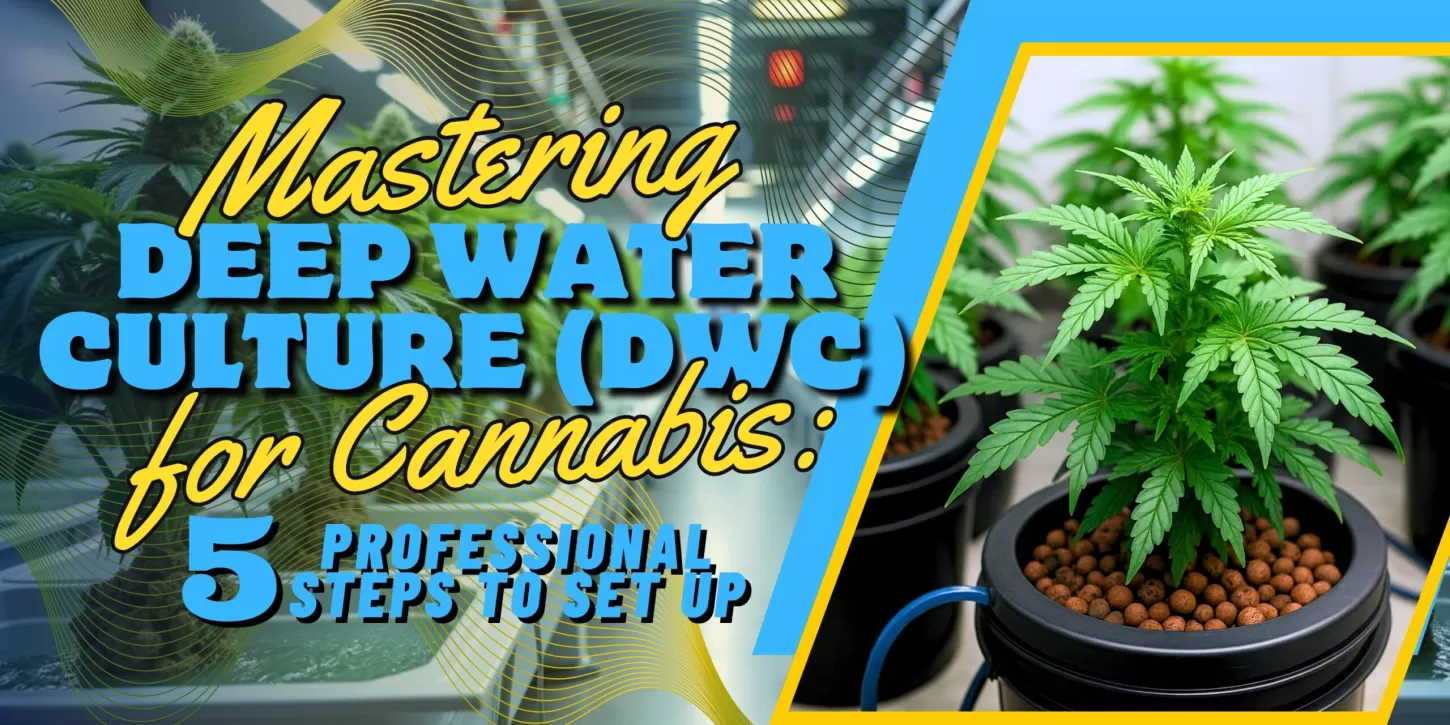
Still among the most effective hydroponics techniques to reach rapid cannabis development and higher yields is Deep Water Culture (DWC). DWC removes soil restrictions for plants to dedicate all their efforts to producing leaves and blooms by keeping plant roots underwater in oxygen- and nutrient-rich water. Regular exposure to oxygen, water, and nutrients simultaneously enhances aggressive root development and accelerates nutrient absorption. Apart from speed, DWC cannabis designs reduce typical soil pests and diseases, therefore reducing infestation and contamination risks. With this book, we introduce not only technical installation processes but also the required knowledge to make your system more durable and efficient.
Root oxygenation forms the foundation of DWC scientific research. Usually lacking oxygen, the roots in stagnant water suffer, but DWC’s aeration constantly prevents hypoxia, which otherwise stunts development and invites root diseases. Second, since growers directly control the ambient conditions and solution composition, DWC lets one precisely manage nutrients. Such management can significantly help cannabis growth to be consistent and strong; DWC is therefore highly sought for both household and commercial use.
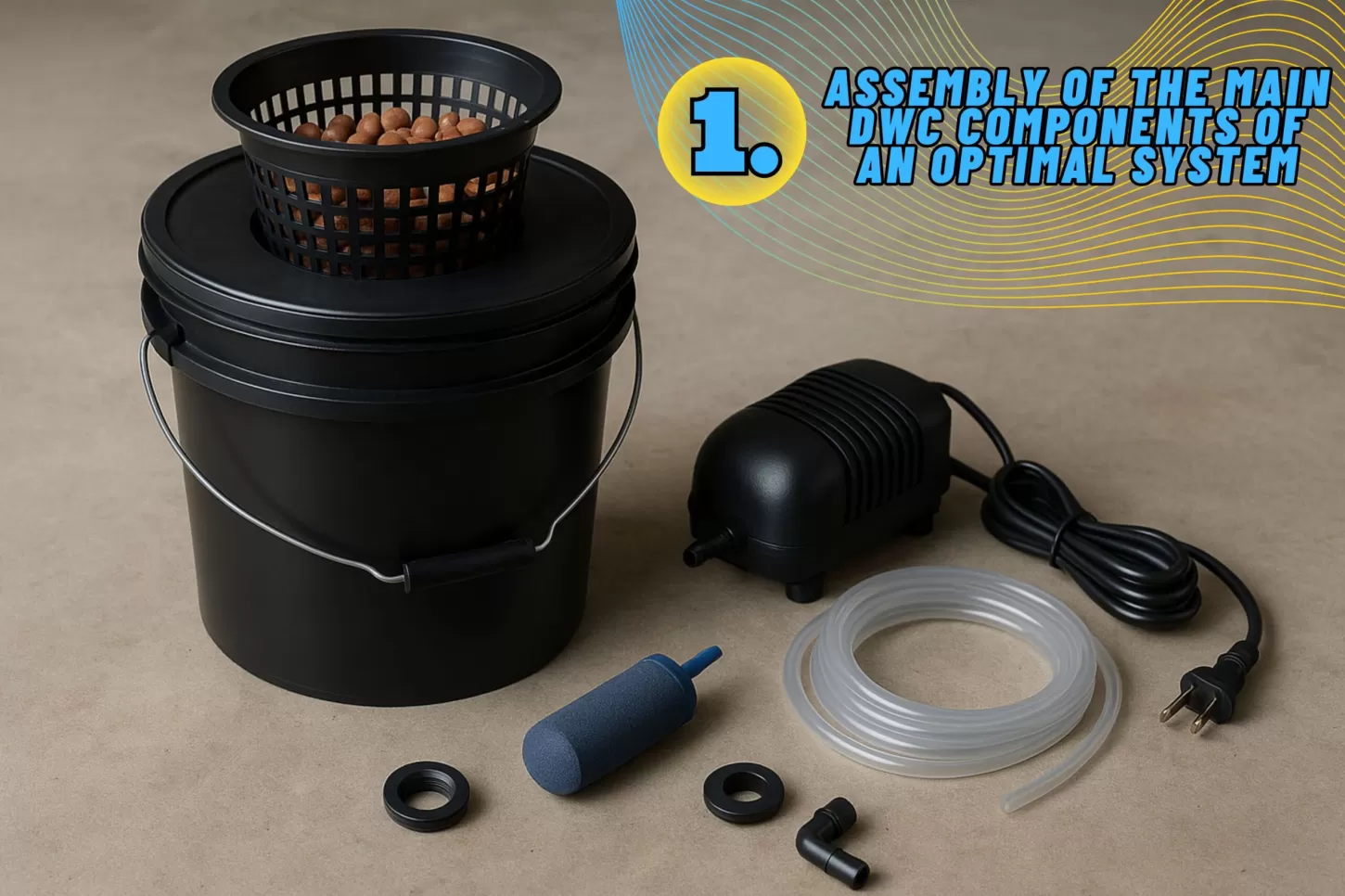
Lying at the basis of a successful cannabis DWC system is choosing the ideal, well-complemented configuration and arrangement of elements. It’s about knowing their purposes, not only about piecing together parts. The reservoir must be light-tight to prevent light from promoting the growth of algae, which compete with roots and root-like plants for oxygen and nutrients. Although reservoir capacity varies, it is generally recommended to provide a minimum of 15–25 liters per plant to ensure ample volume of nutrients and maintain the chemical stability of the solution. Small reservoirs have the possibility of fast pH and temperature fluctuations as well as more frequent filling needs.
Essential in a quality air pump are airstones. To cover losses resulting from tubing length and breaks in RDWC systems, we advise using a pump with a rating well above the minimum air supply. Regular oxygenation promotes rates of nutrient absorption and root hair action. Furthermore, the choice of root media—such as hydroton or expanded clay pebbles—helps the plant as well as offers great aeration and drainage in the area around the stem base. Maintaining system integrity and preventing leakage or oxygen loss depends on all tubing, reservoir grommets, and connections being tight. Before installation, sterilize all parts using hydrogen peroxide or a mild bleach solution; then, rinse completely to ensure no residue remains to damage plant roots.
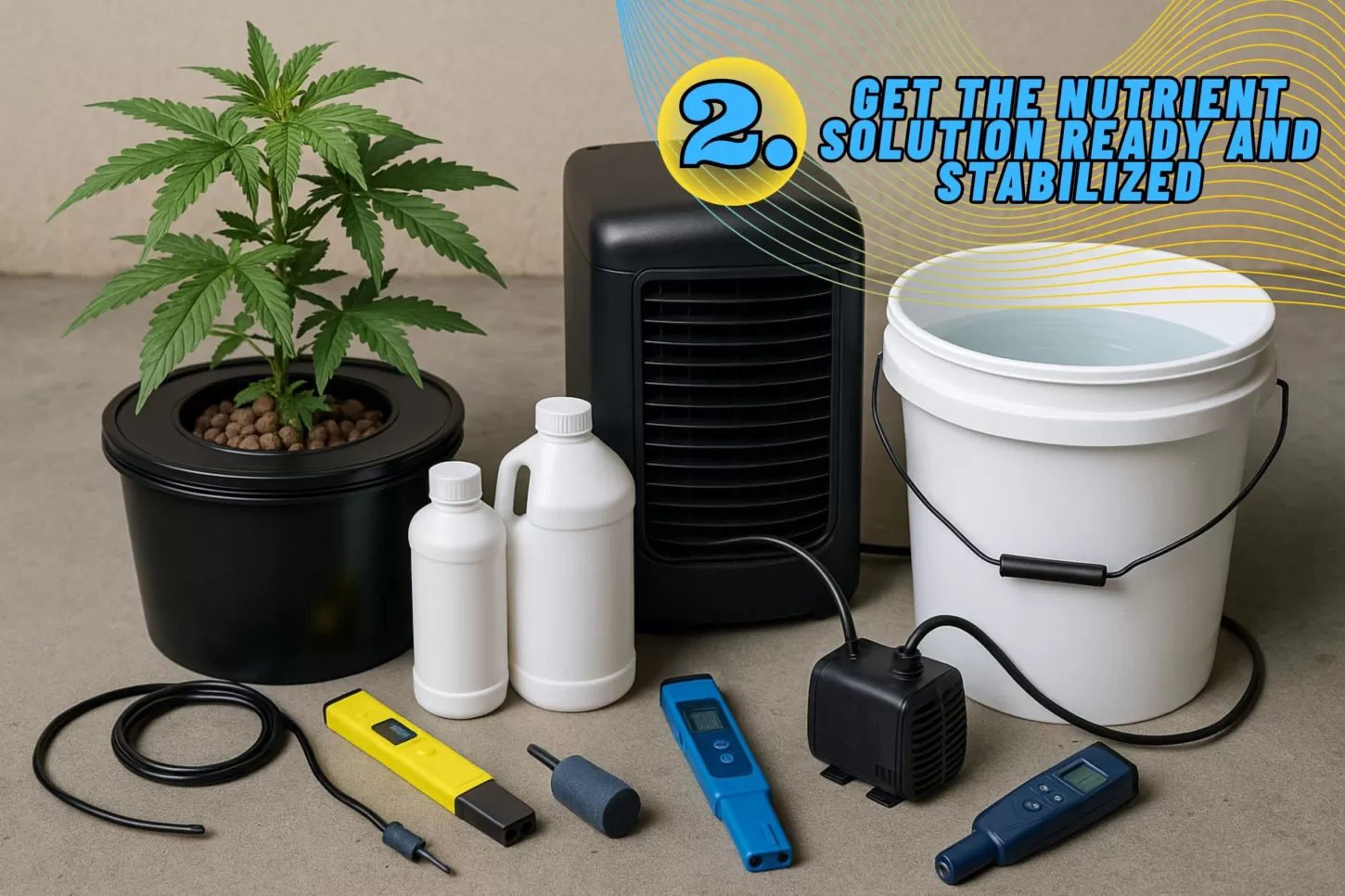
One of the most crucial factors for DWC is the tuning of the parameters of the nutrient solution. It is impossible to overstress temperature regulation of the water; root zone water above 22°C causes dissolved oxygen to diminish and promotes opportunistic infections, including Pythium (root rot). Water chillers or a cold storage reservoir can supply appropriate temperatures and increase root longevity. Since marijuana roots absorb nutrients best under a very strict pH level, pH also needs to be tightly controlled. Variations from the 5.5 to 6.2 range will create lockouts of nutrients where specific elements are unavailable despite their presence in the solution.
Measures of nutrient concentration come from readings of either electrical conductivity (EC) or total dissolved solids (TDS). In terms of the degree of plant development, one must adjust the nutrient strength; too weak will stop growth, and too strong creates nutrient burn and stress. While mature plants need progressively stronger formulations rich in nitrogen during vegetative growth and rising phosphate and potassium when flowering, clones and seedlings are raised gradually. Use high-quality hydroponic nutrient ranges, particularly those marketed for cannabis, to deliver balanced macro- and micronutrients. Always add nutrients in the correct order—calcium nitrate first inhibits precipitation of calcium with sulfates or phosphates. After agitation, let the solution aerate for a minimum of one hour using air stones to stabilize oxygen levels and completely dissolve nutrients.
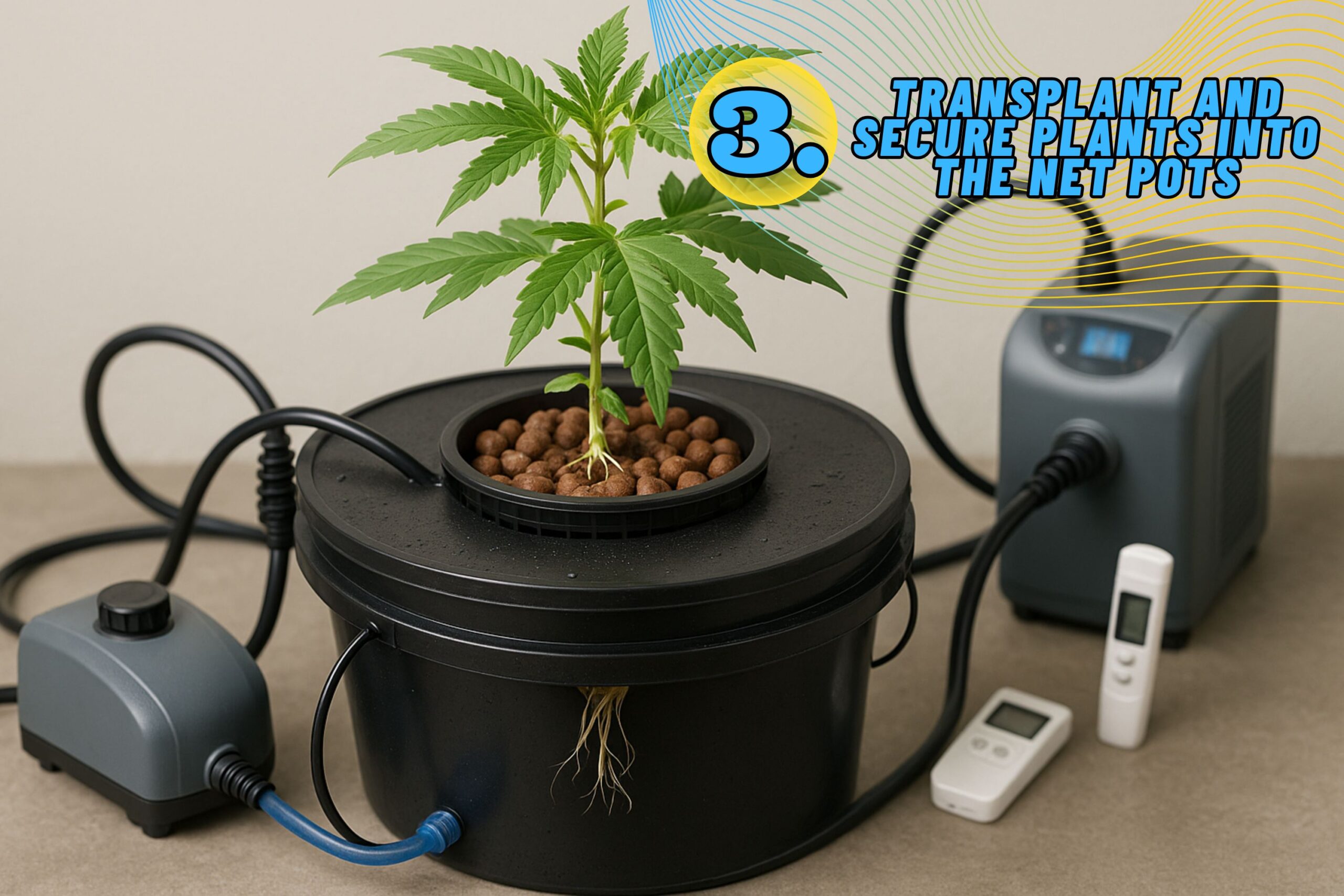
During the transplanting phase, one must exercise caution to prevent transplant shock or damage to the roots, which could lead to either death or slowed growth. Be careful not to rip or crush the fragile root tips while handling clones or seedlings. If necessary, softly wash away any extra growing material to expose the roots before placing them into the net pots. Position the plant so that the stem is vertical and enough room exists for the roots to hang free in the fertilizer solution below.
Gently packing the reservoir’s net pot with clay pebbles will stabilize it without interfering with root development or air penetration. Although initially not completely buried, the water surface in the reservoir must only reach the tips of the roots; this helps root hairs to expand downward and provides maximum oxygen exposure close to the crown. During this transition time, light should be moderate to prevent transplant shock; too strong light causes rapid transpiration and drying out when roots have not yet developed. Early on, maintaining high humidity (65–70%) also helps to decrease leaf evaporation, thus lowering stress.
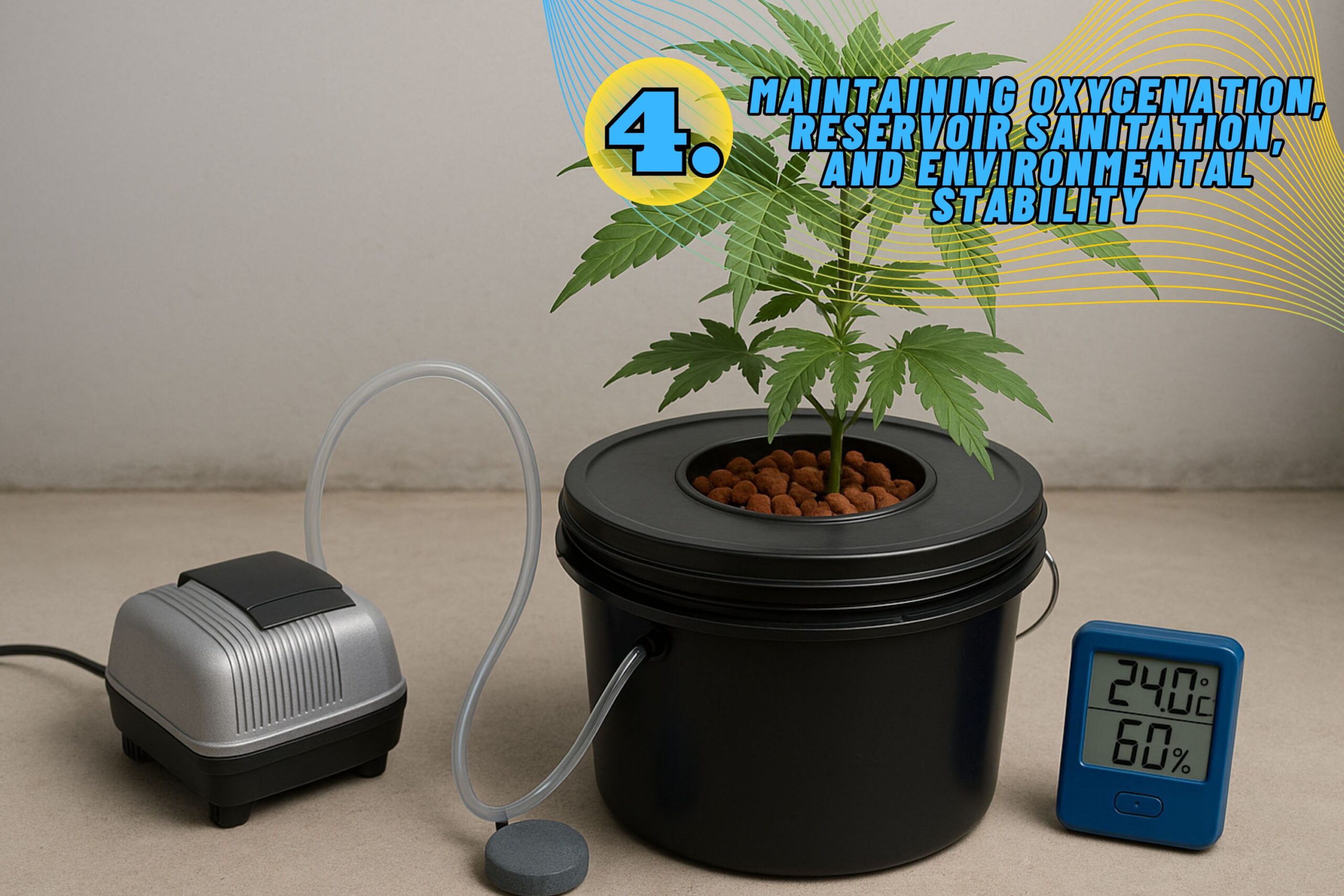
DWC setup supports plant health by means of rigorous environmental control and consistent maintenance. The delivery of oxygen to the roots cannot be compromised; air pumps and rocks must operate continuously. Among the most often occurring causes of DWC breakdown are power interruptions. To maintain airflow during outages, think about getting battery backup or uninterruptible power supplies (UPS). Moreover, constant reservoir monitoring is essential to maintain the equilibrium of nutrient levels, temperature, and solution volume.
Every seven to ten days, reservoir water must be changed to prevent the accumulation of metabolic waste products, including salts. Nutrient imbalances and toxins brought on by this failure impede root function. To inactivate biofilms and pathogenic bacterial colonies, rinse the reservoir gently with an enzymatic cleanser or weak hydrogen peroxide solution as you change the water. Direct influence on transpiration rates and vulnerability to pests and disease includes environmental conditions like air temperature, humidity, and air movement. Consistent conditions—22–26°C air temperature, 55–70% relative humidity for vegetative growth, and moderate air movement—reduce plant stress and maximize healthy growth. The reservoir must be light proofed if algal growth is to be prevented; opaque covers or reflective insulation are advised.
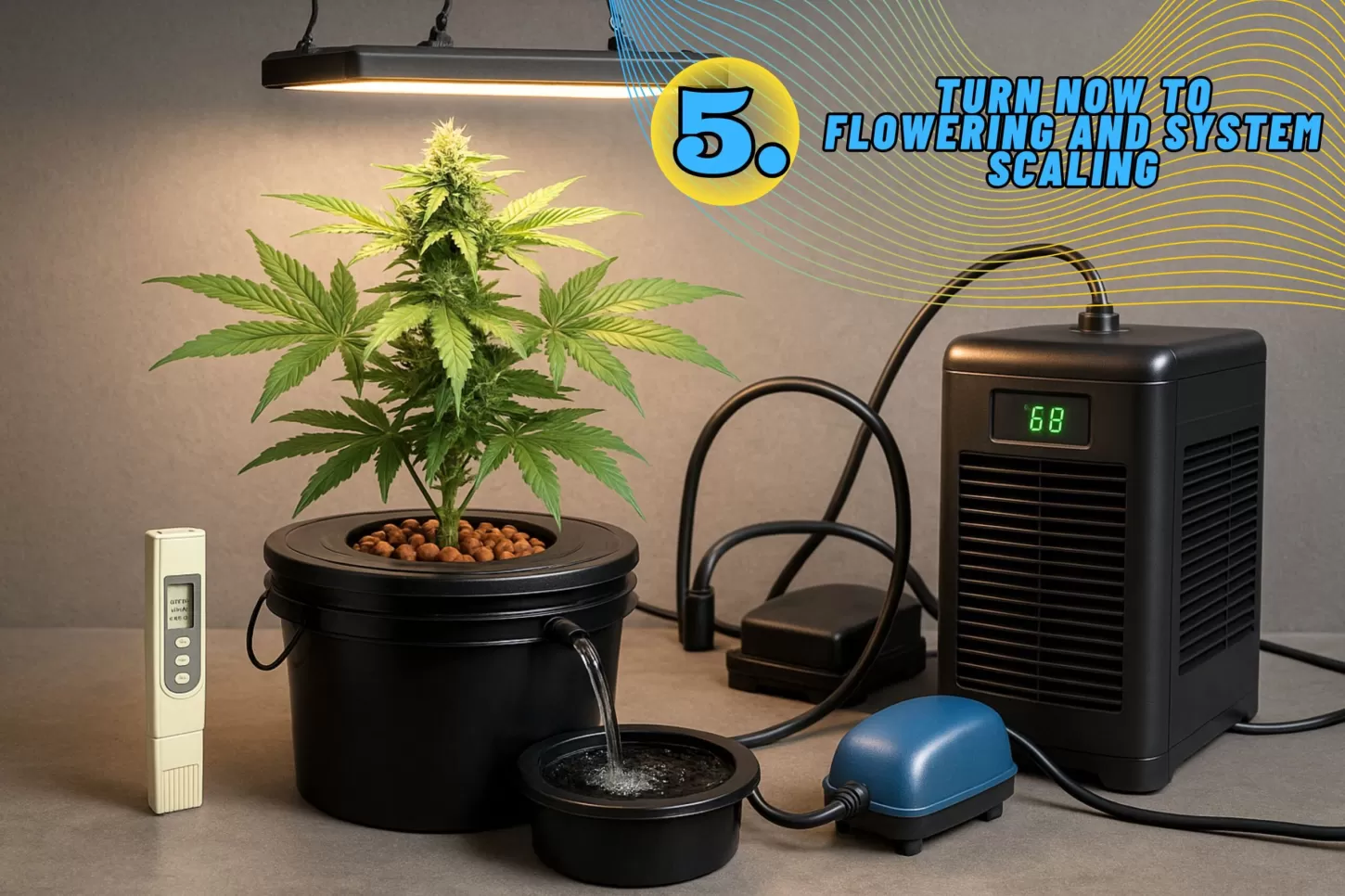
Flowering transition is a vital step in plant physiology and nutritional needs. To encourage the development of buds and resin, cannabis requires a specifically conditioned nutritional mix with high phosphorus and potassium in low nitrogen levels. The change should be implemented gradually to prevent shock. To cause consistent flowering, growers must provide increasing light intensity and change the photoperiod to run 12 hours of light and 12 hours of dark. High-PPFD full-spectrum LED grow lights cut through dense canopies to deliver energy-efficient lighting consistent for floral development.
As buds’ weight and mass grow, more support is required. Mounted either on trellis nets, plant ties, or adjustable supports, these prevent branch breaking from too much weight and guarantee even light distribution in the canopy. A Recirculating Deep Water Culture (RDWC) system can have several plants share one central reservoir of nutrients with tubing routed between manifolds and pumps in larger grows or commercial operations. Its low maintenance times, simple monitoring, and even nutrient distribution are benefits. Scaling calls for careful consideration of oxygenation capability and reservoir volume since possible oxygen shortages or nutrient imbalances may result. Good application of RDWC can significantly increase yield and promote consistent plant quality.
Starting with a one-bucket system before advancing to more intricate RDWC systems will help you maximize success with DWC growing. This process develops basic competency in system maintenance, root observation, and nutrient control. Reverse osmosis (RO) water can help to avoid problems resulting from high mineral content or chlorine in municipal sources, startling plants, or affecting nutrient uptake.
Between crops, regular sterilizing helps to prevent the accumulation of pathogens, biofilm, and algae that grow in stationary hydroponics systems. Sterilant that perform effectively are 3% hydrogen peroxide, enzyme cleansers, or diluted bleach, but they must be completely cleaned out before reuse. At last, also consider adding helpful microbial inoculants made especially for hydroponics use; these may enhance root development, control infections, and, when used sparingly, promote nutrient uptake.

Curious about growing weed in a healthy, effective way? Welcome to the realm of weed hydro! This method uses water instead of soil, delivering n

Peyote Zkittlez is a unique cannabis strain that has quickly gained dedicated followers among enthusiasts and patients alike. Its parentage—Zk

As growers, we want strains that work well, are strong, and are of good quality. Autoflowering cannabis strains are a big step forward for both

Pot growers always ask the same basic question: How much weed does a weed plant produce? The answer is complex and depends on a multitude of var

Ever had the room spin after a few hits? You're not alone. Figuring out how to prevent getting dizzy high can make your cannabis experience a wh

Drying cannabis properly is a critical process in preserving the plant's full aroma and flavor and its psychoactive abilities. Tampering with th

Ever caught yourself a bit too high and all of a sudden in need of being normal? Whether you're heading out for munchies or bumping into someone

Looking for sage advice on how not to get pinched with weed without batting an eye? Attempting to protect your stash from gossipy roommates, sno

Nutrient lockout, also known as nutrient binding or chemical antagonism, is a significant issue in cannabis cultivation that negatively impacts

Germination is the most critical initial stage in growing healthy, high-quality cannabis plants. During germination, the dormant seed becomes a
Are You 21 Or Over?
YesOr
No By clicking yes, you certify that you are over 21 years old. By using this website, you agree to our legal disclaimer.
Excellent blog here Also your website loads up very fast What web host are you using Can I get your affiliate link to your host I wish my web site loaded up as quickly as yours lol
Your writing is not only informative but also incredibly inspiring. You have a knack for sparking curiosity and encouraging critical thinking. Thank you for being such a positive influence!
Simply wish to say your article is as amazing The clearness in your post is just nice and i could assume youre an expert on this subject Well with your permission let me to grab your feed to keep updated with forthcoming post Thanks a million and please carry on the gratifying work
Somebody essentially lend a hand to make significantly articles Id state That is the very first time I frequented your website page and up to now I surprised with the research you made to make this actual submit amazing Wonderful task
Your blog is a beacon of light in the often murky waters of online content. Your thoughtful analysis and insightful commentary never fail to leave a lasting impression. Keep up the amazing work!
Thank you for the auspicious writeup It in fact was a amusement account it Look advanced to more added agreeable from you By the way how could we communicate
Your blog is a constant source of inspiration for me. Your passion for your subject matter shines through in every post, and it’s clear that you genuinely care about making a positive impact on your readers.
Your blog is a constant source of inspiration for me. Your passion for your subject matter is palpable, and it’s clear that you pour your heart and soul into every post. Keep up the incredible work!
Your articles never fail to captivate me. Each one is a testament to your expertise and dedication to your craft. Thank you for sharing your wisdom with the world.
Your blog is a testament to your dedication to your craft. Your commitment to excellence is evident in every aspect of your writing. Thank you for being such a positive influence in the online community.
Your writing has a way of resonating with me on a deep level. I appreciate the honesty and authenticity you bring to every post. Thank you for sharing your journey with us.
Your blog is a true gem in the world of online content. I’m continually impressed by the depth of your research and the clarity of your writing. Thank you for sharing your wisdom with us.
Hi i think that i saw you visited my web site thus i came to Return the favore Im attempting to find things to enhance my siteI suppose its ok to use a few of your ideas
Somebody essentially help to make significantly articles Id state This is the first time I frequented your web page and up to now I surprised with the research you made to make this actual post incredible Fantastic job
Usually I do not read article on blogs however I would like to say that this writeup very compelled me to take a look at and do so Your writing taste has been amazed me Thanks quite nice post
Your blog has quickly become one of my favorites. Your writing is both insightful and thought-provoking, and I always come away from your posts feeling inspired. Keep up the phenomenal work!
Every time I visit your website, I’m greeted with thought-provoking content and impeccable writing. You truly have a gift for articulating complex ideas in a clear and engaging manner.
Hey there You have done a fantastic job I will certainly digg it and personally recommend to my friends Im confident theyll be benefited from this site
I have read some excellent stuff here Definitely value bookmarking for revisiting I wonder how much effort you put to make the sort of excellent informative website
Nice blog here Also your site loads up very fast What host are you using Can I get your affiliate link to your host I wish my site loaded up as quickly as yours lol
What i do not understood is in truth how you are not actually a lot more smartlyliked than you may be now You are very intelligent You realize therefore significantly in the case of this topic produced me individually imagine it from numerous numerous angles Its like men and women dont seem to be fascinated until it is one thing to do with Woman gaga Your own stuffs nice All the time care for it up
Your blog is a beacon of light in the often murky waters of online content. Your thoughtful analysis and insightful commentary never fail to leave a lasting impression. Keep up the amazing work!
Your blog is a breath of fresh air in the often stagnant world of online content. Your thoughtful analysis and insightful commentary never fail to leave a lasting impression. Thank you for sharing your wisdom with us.
Your blog is a beacon of light in the often murky waters of online content. Your thoughtful analysis and insightful commentary never fail to leave a lasting impression. Keep up the amazing work!
Usually I do not read article on blogs however I would like to say that this writeup very compelled me to take a look at and do it Your writing style has been amazed me Thank you very nice article
Your writing has a way of resonating with me on a deep level. I appreciate the honesty and authenticity you bring to every post. Thank you for sharing your journey with us.
This hydroponics guide is quite the buzz, seriously! Who knew growing weed without dirt could be so complicated yet potentially rewarding? The breakdown of systems like DWC and NFT is helpful, though I suspect my cat might confuse the air pump for a toy. The idea of cleaner buds is tempting, especially since explaining hydro weed to my non-growing friends might get messy. And the bit about potential dizziness from hydro weed? Perfect, now I have an excuse for why I always stumble a bit after a grow session. Still, the promise of faster grows and higher yields is hard to ignore, even if it means more trips to the pH meter than to the coffee shop. Overall, a cultivating read for the curious grower!